Exploring Dry-Film FTIR Spectroscopy to Characterize Milk Composition and Subclinical Ketosis throughout a Cow’s Lactation
Abstract
:1. Introduction
2. Materials and Methods
2.1. Production Data
2.2. Feeding and Feed Analysis
2.3. FTIR Analysis
2.4. Data Analysis
2.5. Subclinical Ketosis and β-hydroxybutyrate
3. Results and Discussion
3.1. Chemical Composition of Milk Samples
3.2. The Relationship between Dry-Film FTIR Spectra, DIM and Parity
3.3. Prediction of Fatty Acid Features
3.4. The Relationship between FTIR Spectra and Subclinical Ketosis
3.5. General Discussion
4. Conclusions
Supplementary Materials
Author Contributions
Funding
Informed Consent Statement
Data Availability Statement
Acknowledgments
Conflicts of Interest
References
- Dolecheck, K.; Silvia, W.; Heersche, G., Jr.; Chang, Y.; Ray, D.; Stone, A.; Wadsworth, B.; Bewley, J. Behavioral and physiological changes around estrus events identified using multiple automated monitoring technologies. J. Dairy Sci. 2015, 98, 8723–8731. [Google Scholar] [CrossRef]
- Spiers, D.; Spain, J.; Sampson, J.; Rhoads, R. Use of physiological parameters to predict milk yield and feed intake in heat-stressed dairy cows. J. Therm. Biol. 2004, 29, 759–764. [Google Scholar] [CrossRef]
- Neethirajan, S.J.S.; Research, B.-S. Recent advances in wearable sensors for animal health management. Sens. Bio-Sens. Res. 2017, 12, 15–29. [Google Scholar] [CrossRef] [Green Version]
- Esposito, G.; Irons, P.C.; Webb, E.C.; Chapwanya, A. Interactions between negative energy balance, metabolic diseases, uterine health and immune response in transition dairy cows. Anim. Reprod. Sci. 2014, 144, 60–71. [Google Scholar] [CrossRef] [Green Version]
- Løvendahl, P.; Ridder, C.; Friggens, N.C. Limits to prediction of energy balance from milk composition measures at individual cow level. J. Dairy Sci. 2010, 93, 1998–2006. [Google Scholar] [CrossRef]
- Gross, J.J.; van Dorland, H.A.; Bruckmaier, R.; Schwarz, F.J. Milk fatty acid profile related to energy balance in dairy cows. J. Dairy Sci. 2011, 78, 479–488. [Google Scholar] [CrossRef] [Green Version]
- Palmquist, D.; Beaulieu, A.D.; Barbano, D.J. Feed and animal factors influencing milk fat composition. J. Dairy Sci. 1993, 76, 1753–1771. [Google Scholar] [CrossRef]
- Stoop, W.; Bovenhuis, H.; Heck, J.; Van Arendonk, J. Effect of lactation stage and energy status on milk fat composition of Holstein-Friesian cows. J. Dairy Sci. 2009, 92, 1469–1478. [Google Scholar] [CrossRef]
- Van Haelst, Y.; Beeckman, A.; Van Knegsel, A.; Fievez, V. Elevated concentrations of oleic acid and long-chain fatty acids in milk fat of multiparous subclinical ketotic cows. J. Dairy Sci. 2008, 91, 4683–4686. [Google Scholar] [CrossRef] [PubMed]
- Martin, A.D.; Afseth, N.K.; Kohler, A.; Randby, Å.; Eknæs, M.; Waldmann, A.; Dørum, G.; Måge, I.; Reksen, O. The relationship between fatty acid profiles in milk identified by Fourier transform infrared spectroscopy and onset of luteal activity in Norwegian dairy cattle. J. Dairy Sci. 2015, 98, 5374–5384. [Google Scholar] [CrossRef] [PubMed] [Green Version]
- Diaz-Olivares, J.A.; Adriaens, I.; Stevens, E.; Saeys, W.; Aernouts, B. Online milk composition analysis with an on-farm near-infrared sensor. Comput. Electron. Agric. 2020, 178, 105734. [Google Scholar] [CrossRef]
- Bresolin, T.; Dórea, J.R. Infrared Spectrometry as a High-Throughput Phenotyping Technology to Predict Complex Traits in Livestock Systems. Front. Genet. 2020, 11, 923. [Google Scholar] [CrossRef]
- Rutten, M.; Bovenhuis, H.; Hettinga, K.; Van Valenberg, H.; Van Arendonk, J. Predicting bovine milk fat composition using infrared spectroscopy based on milk samples collected in winter and summer. J. Dairy Sci. 2009, 92, 6202–6209. [Google Scholar] [CrossRef] [PubMed] [Green Version]
- Soyeurt, H.; Dehareng, F.; Gengler, N.; McParland, S.; Wall, E.; Berry, D.; Coffey, M.; Dardenne, P. Mid-infrared prediction of bovine milk fatty acids across multiple breeds, production systems, and countries. J. Dairy Sci. 2011, 94, 1657–1667. [Google Scholar] [CrossRef] [PubMed] [Green Version]
- Bresolin, D.; Hawerroth, B.; de Oliveira Romera, C.; Sayer, C.; de Araújo, P.H.H.; de Oliveira, D. Immobilization of lipase Eversa Transform 2.0 on poly (urea–urethane) nanoparticles obtained using a biopolyol from enzymatic glycerolysis. Bioprocess Biosyst. Eng. 2020, 43, 1279–1286. [Google Scholar] [CrossRef] [PubMed]
- De Marchi, M.; Toffanin, V.; Cassandro, M.; Penasa, M. Invited review: Mid-infrared spectroscopy as phenotyping tool for milk traits. J. Dairy Sci. 2014, 97, 1171–1186. [Google Scholar] [CrossRef]
- McParland, S.; Berry, D. The potential of Fourier transform infrared spectroscopy of milk samples to predict energy intake and efficiency in dairy cows. J. Dairy Sci. 2016, 99, 4056–4070. [Google Scholar] [CrossRef]
- Aernouts, B.; Adriaens, I.; Diaz-Olivares, J.; Saeys, W.; Mäntysaari, P.; Kokkonen, T.; Mehtiö, T.; Kajava, S.; Lidauer, P.; Lidauer, M.H. Mid-infrared spectroscopic analysis of raw milk to predict the blood nonesterified fatty acid concentrations in dairy cows. J. Dairy Sci. 2020, 103, 6422–6438. [Google Scholar] [CrossRef]
- Bonfatti, V.; Turner, S.-A.; Kuhn-Sherlock, B.; Luke, T.; Ho, P.; Phyn, C.; Pryce, J. Prediction of blood β-hydroxybutyrate content and occurrence of hyperketonemia in early-lactation, pasture-grazed dairy cows using milk infrared spectra. J. Dairy Sci. 2019, 102, 6466–6476. [Google Scholar] [CrossRef]
- Luke, T.; Rochfort, S.; Wales, W.; Bonfatti, V.; Marett, L.; Pryce, J. Metabolic profiling of early-lactation dairy cows using milk mid-infrared spectra. J. Dairy Sci. 2019, 102, 1747–1760. [Google Scholar] [CrossRef] [Green Version]
- Aernouts, B.; Polshin, E.; Lammertyn, J.; Saeys, W. Visible and near-infrared spectroscopic analysis of raw milk for cow health monitoring: Reflectance or transmittance? J. Dairy Sci. 2011, 94, 5315–5329. [Google Scholar] [CrossRef] [PubMed] [Green Version]
- Aernouts, B.; Polshin, E.; Saeys, W.; Lammertyn, J. Mid-infrared spectrometry of milk for dairy metabolomics: A comparison of two sampling techniques and effect of homogenization. Anal. Chim. Acta 2011, 705, 88–97. [Google Scholar] [CrossRef]
- Afseth, N.K.; Martens, H.; Randby, Å.; Gidskehaug, L.; Narum, B.; Jørgensen, K.; Lien, S.; Kohler, A. Predicting the fatty acid composition of milk: A comparison of two Fourier transform infrared sampling techniques. Appl. Spectrosc. 2010, 64, 700–707. [Google Scholar] [CrossRef]
- Berget, B.; Ekeberg, Ø.; Pedersen, I.; Braastad, B.O. Animal-assisted therapy with farm animals for persons with psychiatric disorders: Effects on anxiety and depression, a randomized controlled trial. Occup. Ther. Ment. Health 2011, 27, 50–64. [Google Scholar] [CrossRef]
- Berget, I.; Martens, H.; Kohler, A.; Sjurseth, S.; Afseth, N.; Narum, B.; Ådnøy, T.; Lien, S. Caprine CSN1S1 haplotype effect on gene expression and milk composition measured by Fourier transform infrared spectroscopy. J. Dairy Sci. 2010, 93, 4340–4350. [Google Scholar] [CrossRef] [PubMed] [Green Version]
- Kuligowski, J.; Schwaighofer, A.; Alcaráz, M.R.; Quintás, G.; Mayer, H.; Vento, M.; Lendl, B. External cavity-quantum cascade laser (EC-QCL) spectroscopy for protein analysis in bovine milk. Anal. Chim. Acta 2017, 963, 99–105. [Google Scholar] [CrossRef]
- Rachah, A.; Reksen, O.; Afseth, N.K.; Tafintseva, V.; Ferneborg, S.; Martin, A.D.; Kohler, A.; Prestløkken, E. Fourier transform infrared spectroscopy of milk samples as a tool to estimate energy balance, energy-and dry matter intake in lactating dairy cows. J. Dairy Res. 2020, 87, 436–443. [Google Scholar] [CrossRef] [PubMed]
- Kidane, A.; Øverland, M.; Mydland, L.T.; Prestløkken, E. Milk production of Norwegian Red dairy cows on silages presumed either low or optimal in dietary crude protein content. Livest. Sci. 2018, 214, 42–50. [Google Scholar] [CrossRef]
- Volden, H. NorFor-: The Nordic Feed Evaluation System; Springer Science & Business Media: Berlin/Heidelberg, Germany, 2011; Volume 30. [Google Scholar]
- Savitzky, A.; Golay, M. Smoothing and differentiation of data by simplified least squares procedures. Anal. Chem. 1964, 36, 1627–1639. [Google Scholar] [CrossRef]
- Afseth, N.K.; Kohler, A. Extended multiplicative signal correction in vibrational spectroscopy, a tutorial. Chemom. Intell. Lab. Syst. 2012, 117, 92–99. [Google Scholar] [CrossRef]
- Tafintseva, V.; Vigneau, E.; Shapaval, V.; Cariou, V.; Qannari, E.M.; Kohler, A. Hierarchical classification of microorganisms based on high-dimensional phenotypic data. J. Biophotonics 2018, 11, e201700047. [Google Scholar] [CrossRef] [PubMed]
- Karaman, İ.; Qannari, E.M.; Martens, H.; Hedemann, M.S.; Knudsen, K.E.B.; Kohler, A. Comparison of Sparse and Jack-knife partial least squares regression methods for variable selection. Chemom. Intell. Lab. Syst. 2013, 122, 65–77. [Google Scholar] [CrossRef]
- Council, N.R. Factors affecting the composition of milk from dairy cows. In Designing foods: Animal Product Options in the Marketplace; National Academies Press (US): Washington, DC, USA, 1988. [Google Scholar]
- Tsioulpas, A.; Grandison, A.; Lewis, M. Changes in physical properties of bovine milk from the colostrum period to early lactation. J. Dairy Sci. 2007, 90, 5012–5017. [Google Scholar] [CrossRef] [PubMed]
- Ptak, E.; Brzozowski, P.; Bieniek, J. Genetic parameters for lactose percentage in the milk of Polish Holstein-Friesians. J. Anim. Feed. Sci. 2012, 21, 251–262. [Google Scholar] [CrossRef] [Green Version]
- Stehr, F.J.M. Fourier Transform Infrared Spectroscopy (FTIR) for Detection and Quantification of Milk Components for Cattle Health Monitoring. Master’s Thesis, Norwegian University of Life Sciences, Ås, Norway, 2017. [Google Scholar]
- Akhgar, C.K.; Nürnberger, V.; Nadvornik, M.; Velik, M.; Schwaighofer, A.; Rosenberg, E.; Lendl, B. Fatty Acid Prediction in Bovine Milk by Attenuated Total Reflection Infrared Spectroscopy after Solvent-Free Lipid Separation. Foods 2021, 10, 1054. [Google Scholar] [CrossRef] [PubMed]
- Eskildsen, C.E.; Næs, T.; Skou, P.B.; Solberg, L.E.; Dankel, K.R.; Basmoen, S.A.; Wold, J.P.; Horn, S.S.; Hillestad, B.; Poulsen, N.A.J.C.; et al. Cage of covariance in calibration modeling: Regressing multiple and strongly correlated response variables onto a low rank subspace of explanatory variables. Chemom. Intell. Lab. Syst. 2021, 213, 104311. [Google Scholar] [CrossRef]
- Andersen, F.; Østerås, O.; Reksen, O.; Toft, N.; Gröhn, Y.T.J.A.V.S. Associations between the time of conception and the shape of the lactation curve in early lactation in Norwegian dairy cattle. Acta Vet. Scand. 2011, 53, 1–8. [Google Scholar] [CrossRef] [Green Version]
- Bauman, D.E.; Currie, W.B.J.J.o.d.s. Partitioning of nutrients during pregnancy and lactation: A review of mechanisms involving homeostasis and homeorhesis. J. Dairy Sci. 1980, 63, 1514–1529. [Google Scholar] [CrossRef]
- Herring, A.D. Beef Cattle Production Systems; CABI: Wallingford, UK, 2014. [Google Scholar]
- Walsh, S.; Williams, E.; Evans, A.J.A.r.s. A review of the causes of poor fertility in high milk producing dairy cows. Anim. Reprod. Sci. 2011, 123, 127–138. [Google Scholar] [CrossRef]
- Xiong, Y.; Shapaval, V.; Kohler, A.; Li, J.; From, P.J.J.I.A. A fully automated robot for the preparation of fungal samples for FTIR spectroscopy using deep learning. IEEE Access 2019, 7, 132763–132774. [Google Scholar] [CrossRef]
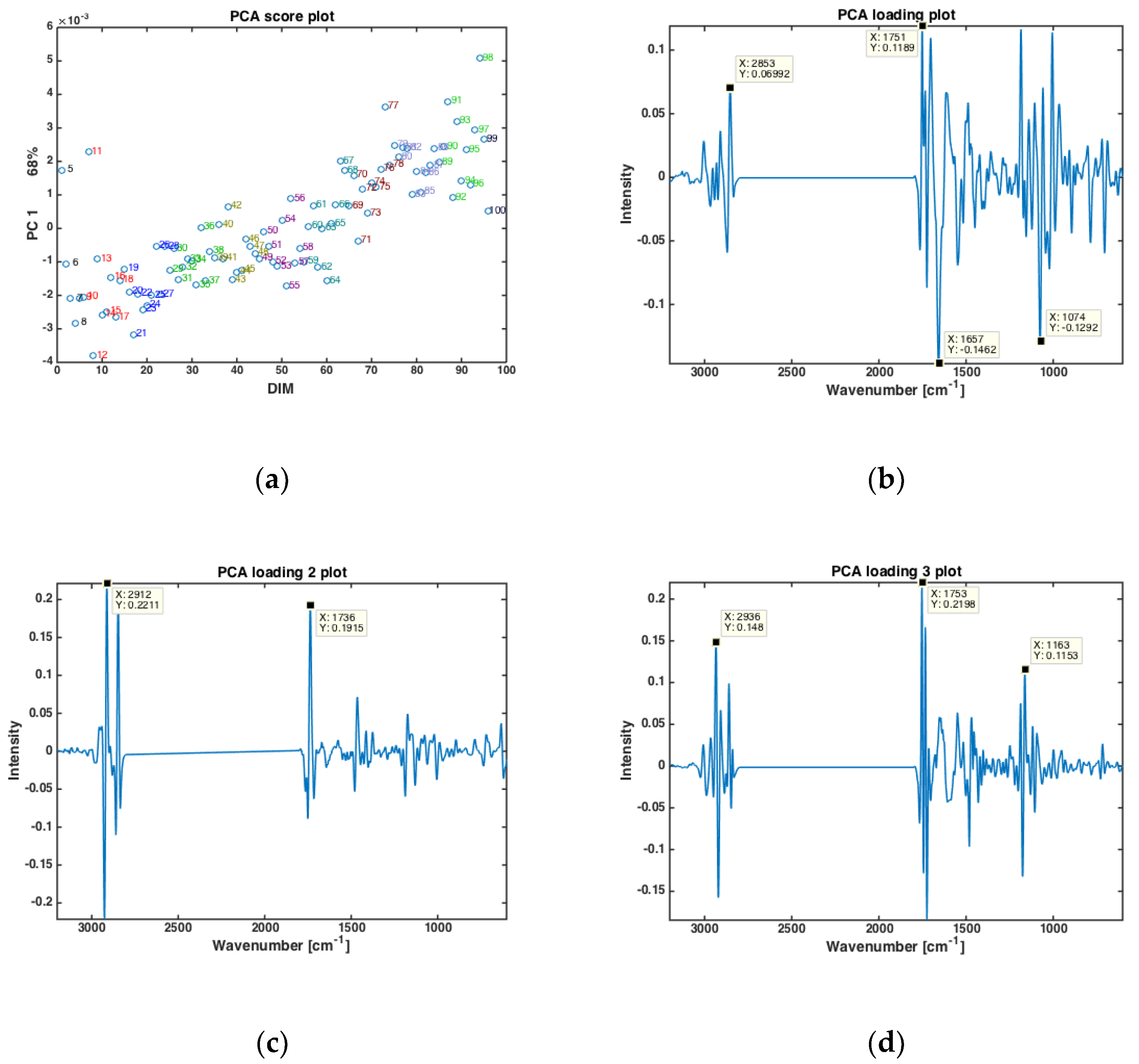
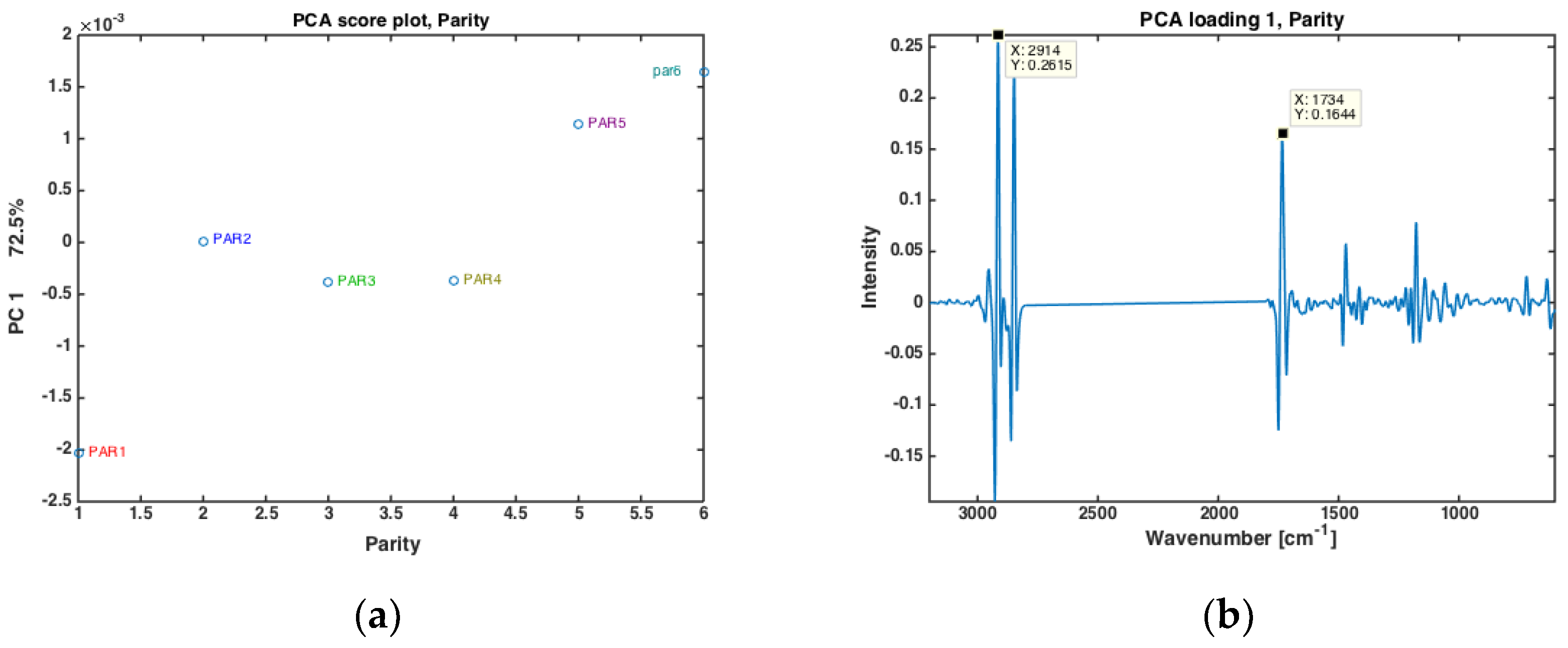
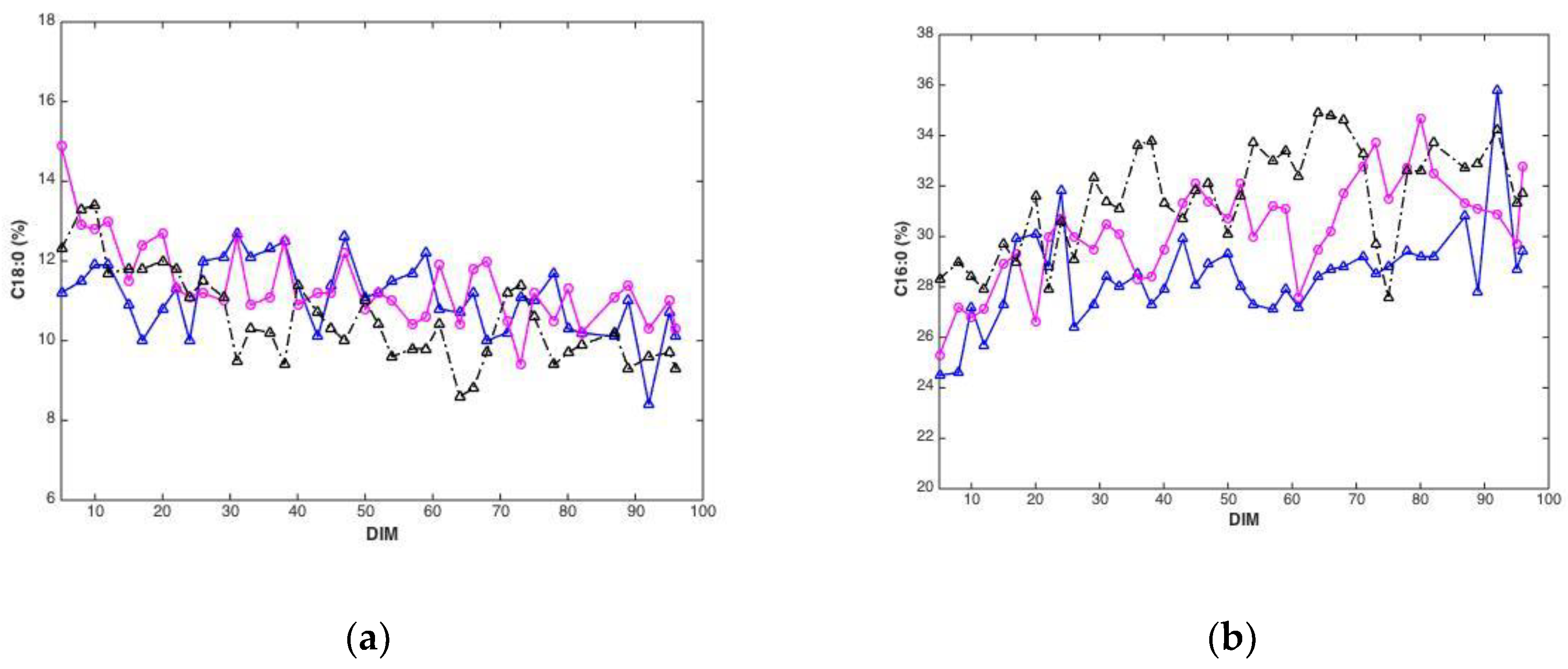
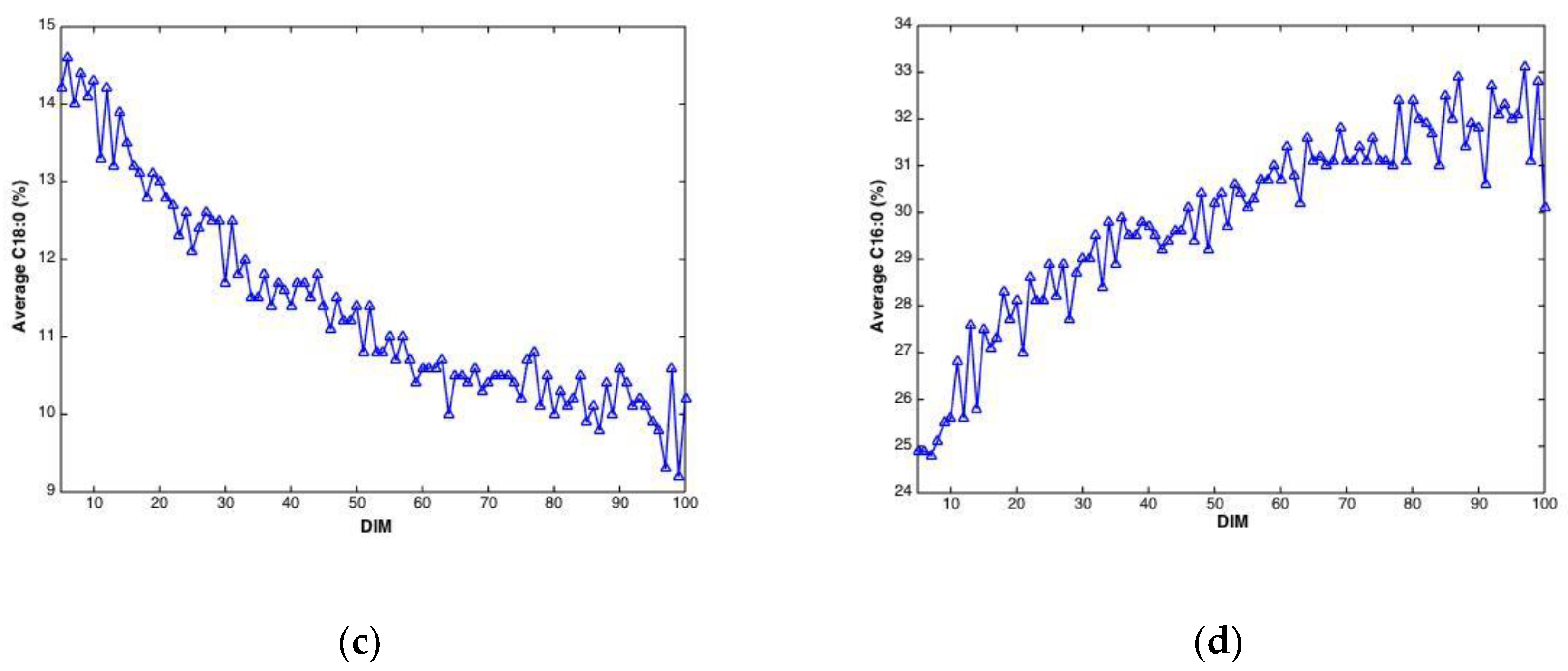
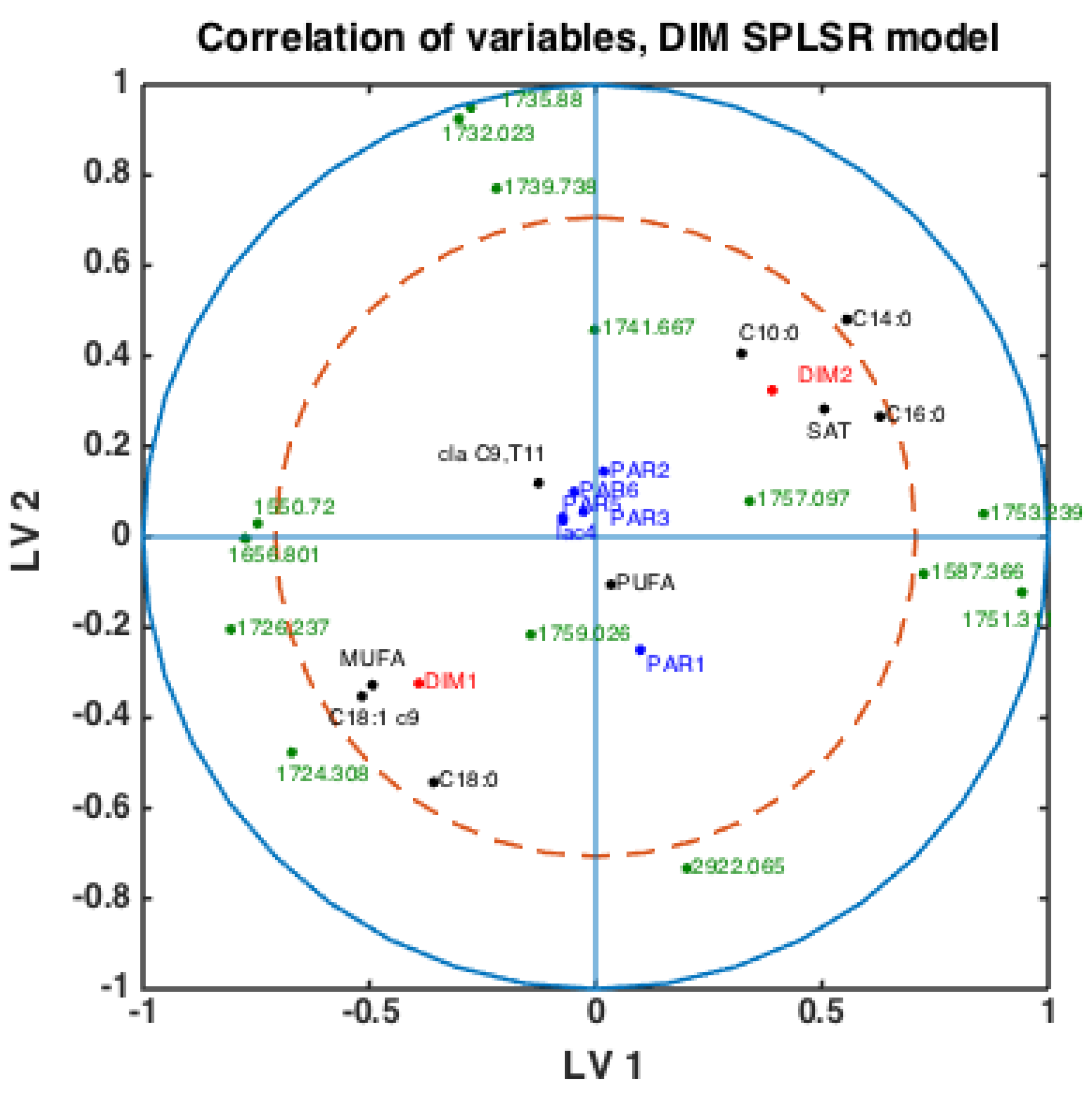
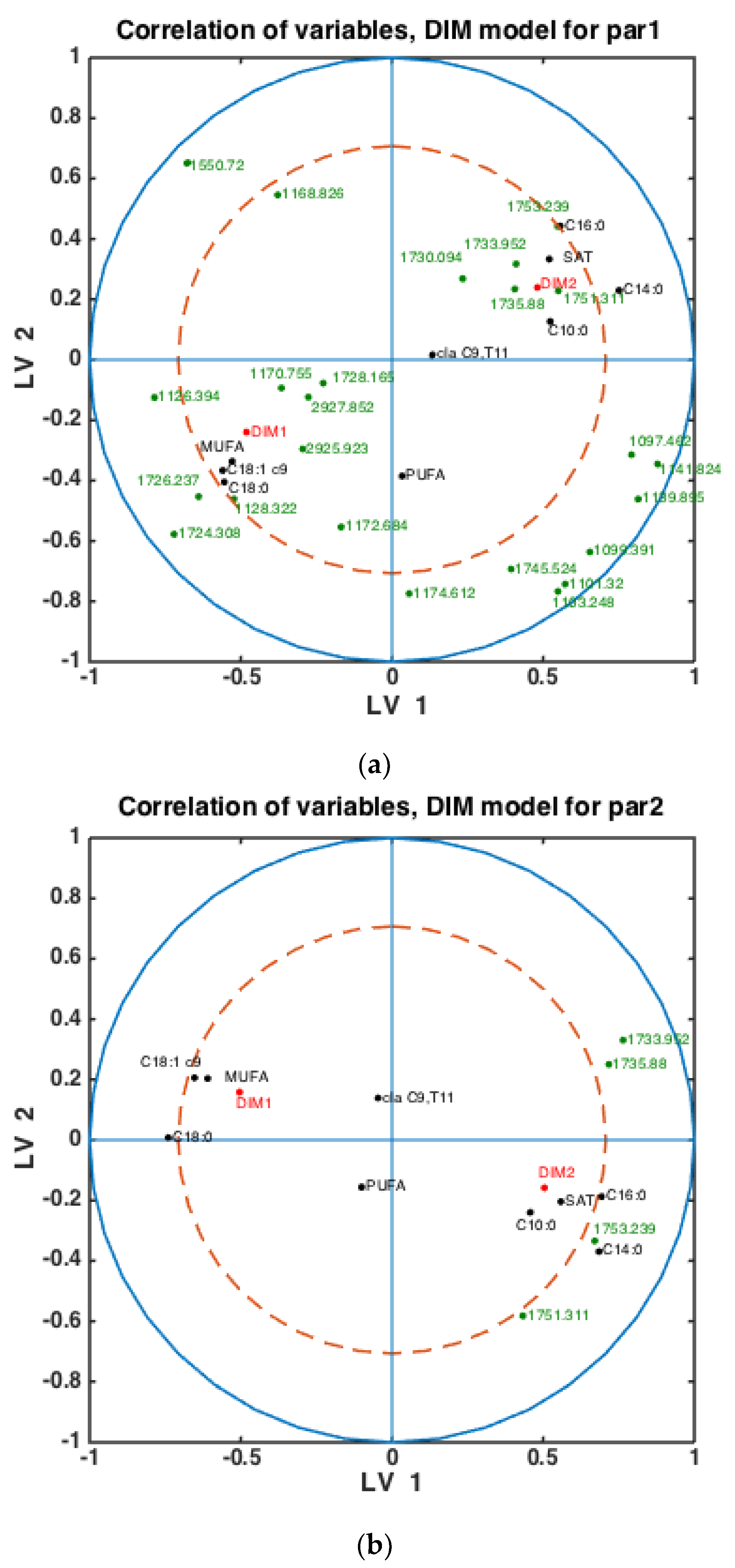
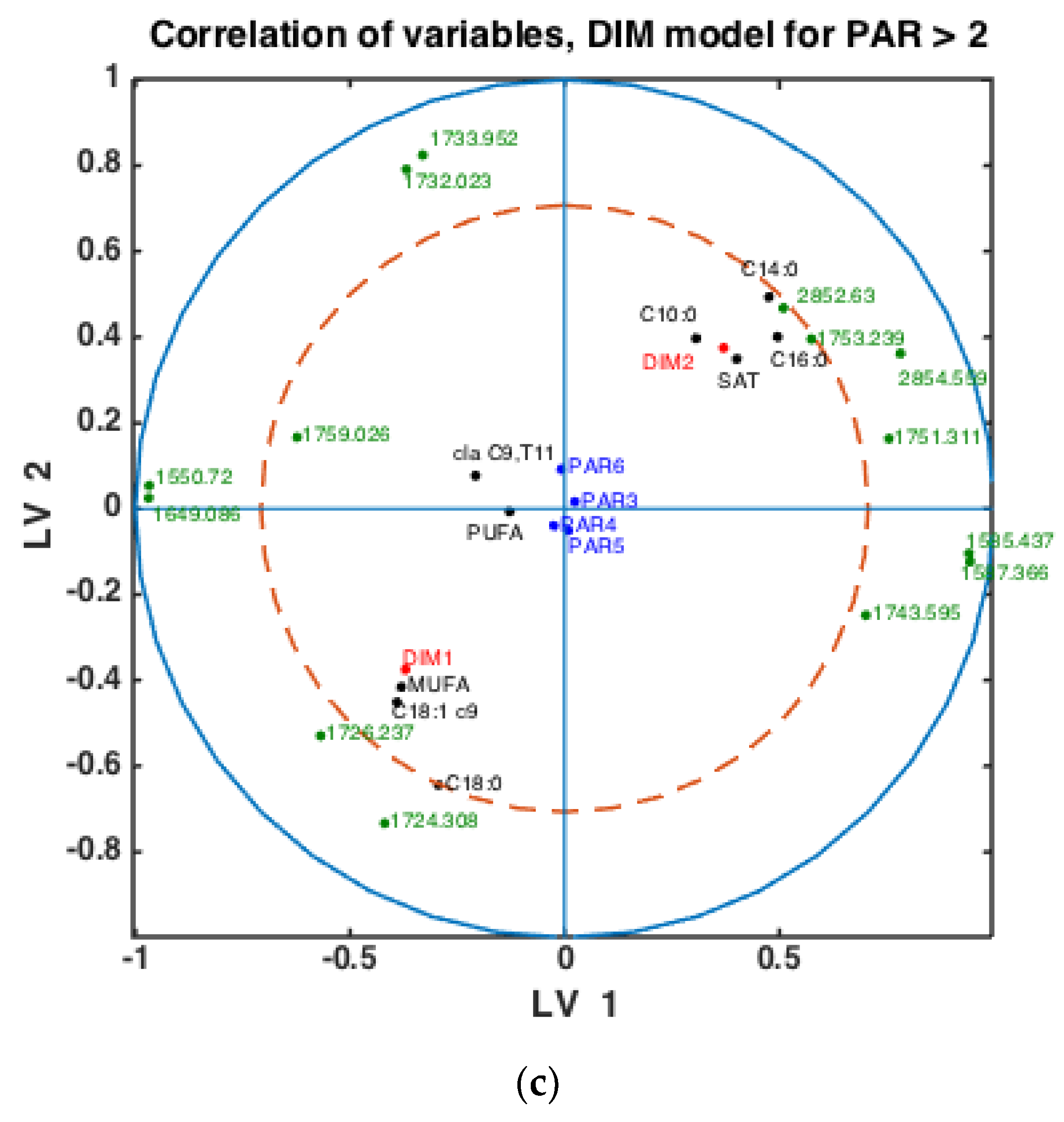
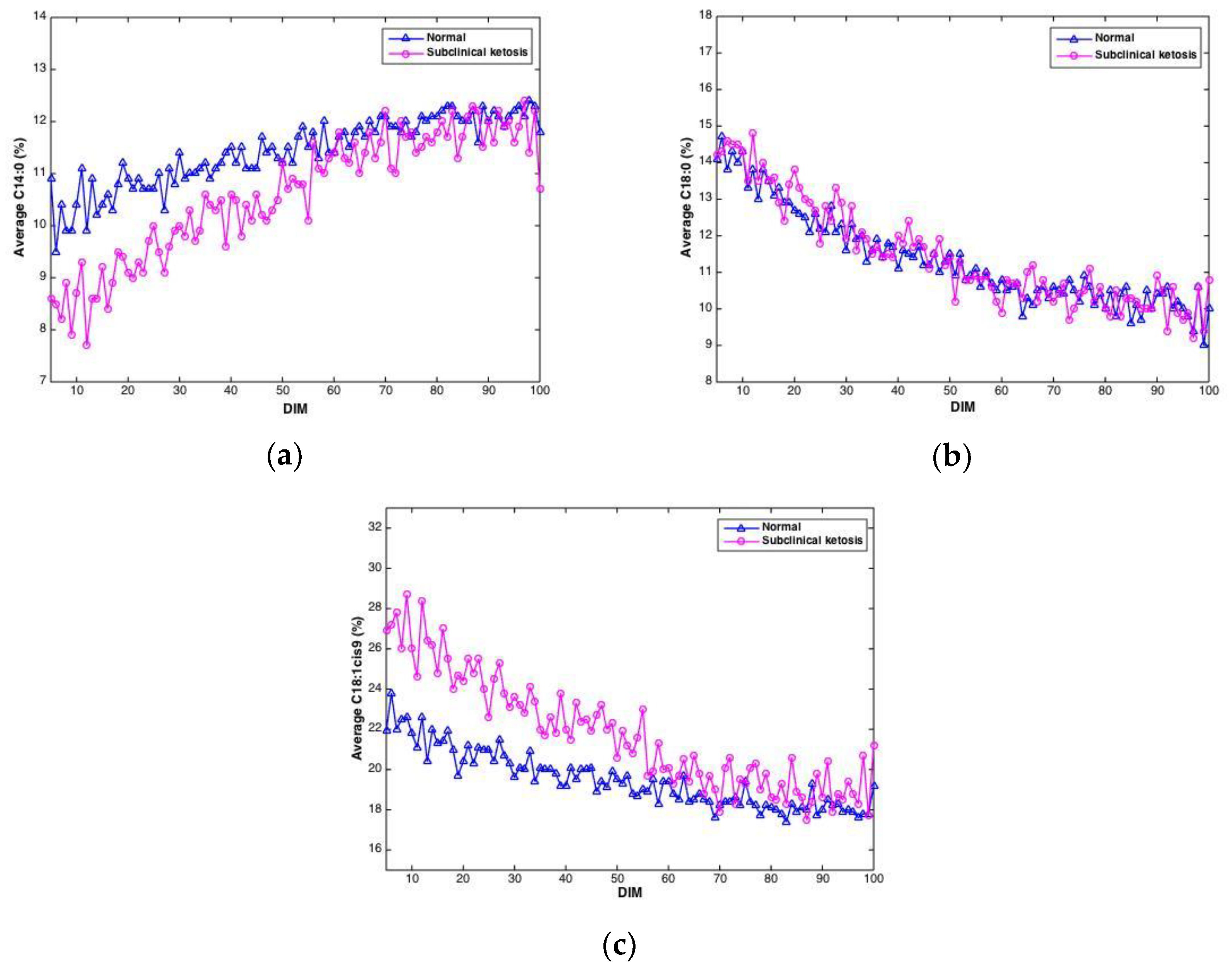
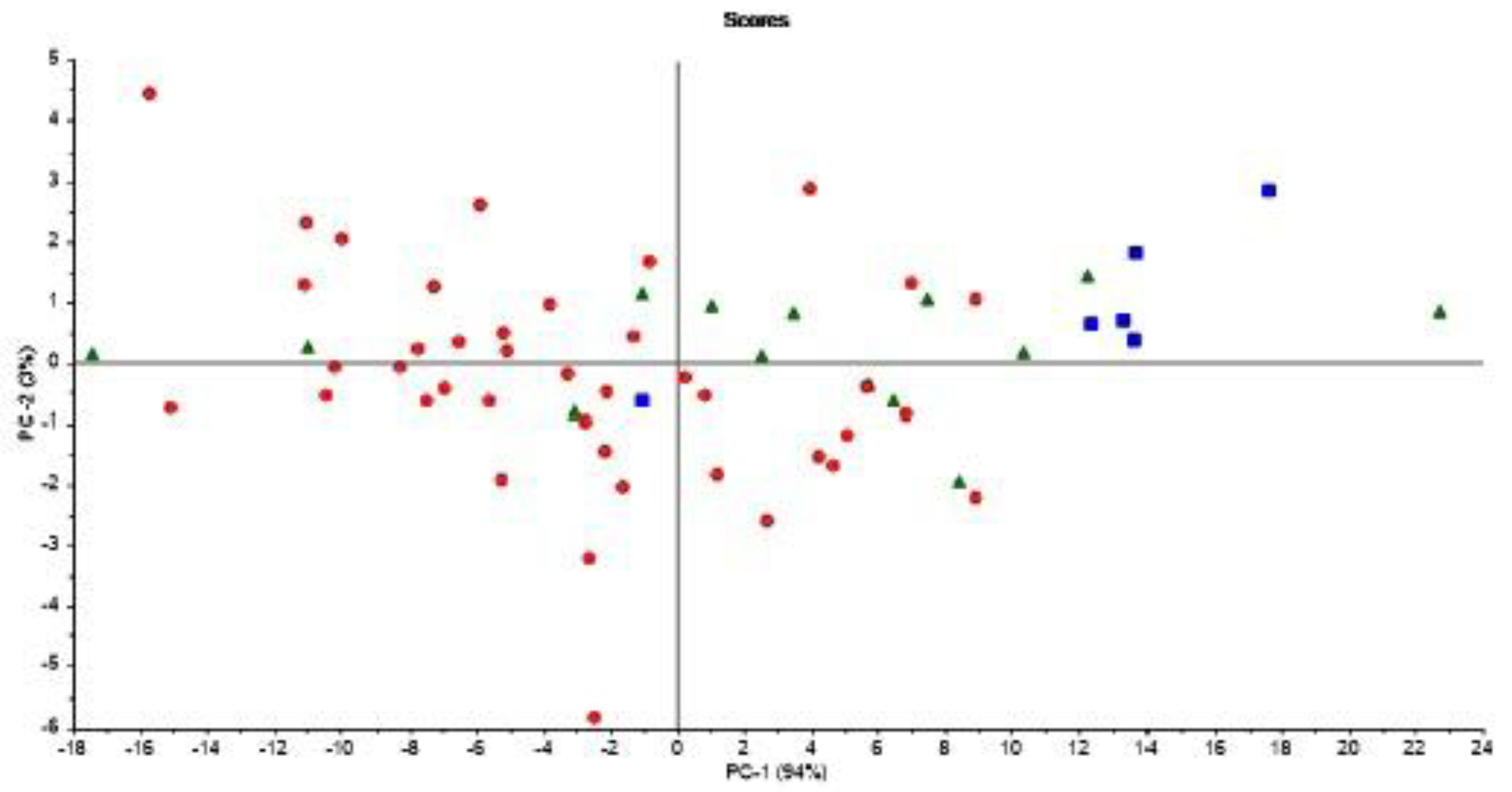
| Early Harvest | Normal Harvest | Concentrate | |
|---|---|---|---|
| Dry matter (g/kg feed) | 261 ± 23.5 | 359 ± 10.2 | 878 |
| Ash | 75 ± 2.5 | 62 ± 1.9 | 78 |
| Crude protein | 151 ± 6.9 | 127 ± 5.8 | 277 |
| Crude fat | 31 ± 1.9 | 27 ± 1.9 | 65 |
| aNDFom 1 | 579 ± 7.1 | 614 ± 7.6 | 179 |
| iNDF 2 (g/kg NDF) | 134 ± 59 | 206 ± 32 | 206 |
| Starch | 289 | ||
| OMD 3 (%) | 80.3 ± 1.6 | 71.9 ± 5.6 | |
| NEL20 4 (MJ/kg DM) | 6.75 ± 0.0 | 6.18 ± 0.0 | 7.35 |
| AAT20 | 80.5 ± 2.1 | 77.0 ± 2.8 | 163 |
| PBV20 | 42.5 ± 2.1 | 9.0 ± 24.0 | 41 |
| Chemical Component | Min | Max | Mean | SD |
|---|---|---|---|---|
| Fat (%) 1 | 2.0 | 8.0 | 4.0 | 1.0 |
| Protein (%) 1 | 2.5 | 4.7 | 3.4 | 0.3 |
| Lactose (%) 1 | 4.1 | 5.5 | 4.9 | 0.2 |
| Urea (mmol/L) | 2.4 | 8.3 | 5.1 | 0.8 |
| FFAs 2 (mmol/L) | 0.1 | 5.4 | 0.5 | 0.4 |
| Chemical Component | Min | Max | Mean | SD |
|---|---|---|---|---|
| C10:0 | 0.5 | 6.1 | 3.1 | 0.7 |
| C14:0 | 4.1 | 23.0 | 11.1 | 1.6 |
| C16:0 | 16.0 | 43.5 | 27.9 | 3.1 |
| C18:0 | 3.7 | 22.1 | 11.5 | 1.9 |
| C18:1cis-9 | 7.1 | 39.4 | 20.3 | 3.6 |
| CLA 1 | 0 | 1.1 | 0.5 | 0.1 |
| SAT 1 | 46.4 | 76.8 | 67.5 | 4.0 |
| MUFA 1 | 14.9 | 46.2 | 24.9 | 3.9 |
| PUFA 1 | 1.4 | 4.9 | 2.3 | 0.3 |
Publisher’s Note: MDPI stays neutral with regard to jurisdictional claims in published maps and institutional affiliations. |
© 2021 by the authors. Licensee MDPI, Basel, Switzerland. This article is an open access article distributed under the terms and conditions of the Creative Commons Attribution (CC BY) license (https://creativecommons.org/licenses/by/4.0/).
Share and Cite
Rachah, A.; Reksen, O.; Tafintseva, V.; Stehr, F.J.M.; Rukke, E.-O.; Prestløkken, E.; Martin, A.; Kohler, A.; Afseth, N.K. Exploring Dry-Film FTIR Spectroscopy to Characterize Milk Composition and Subclinical Ketosis throughout a Cow’s Lactation. Foods 2021, 10, 2033. https://doi.org/10.3390/foods10092033
Rachah A, Reksen O, Tafintseva V, Stehr FJM, Rukke E-O, Prestløkken E, Martin A, Kohler A, Afseth NK. Exploring Dry-Film FTIR Spectroscopy to Characterize Milk Composition and Subclinical Ketosis throughout a Cow’s Lactation. Foods. 2021; 10(9):2033. https://doi.org/10.3390/foods10092033
Chicago/Turabian StyleRachah, Amira, Olav Reksen, Valeria Tafintseva, Felicia Judith Marie Stehr, Elling-Olav Rukke, Egil Prestløkken, Adam Martin, Achim Kohler, and Nils Kristian Afseth. 2021. "Exploring Dry-Film FTIR Spectroscopy to Characterize Milk Composition and Subclinical Ketosis throughout a Cow’s Lactation" Foods 10, no. 9: 2033. https://doi.org/10.3390/foods10092033
APA StyleRachah, A., Reksen, O., Tafintseva, V., Stehr, F. J. M., Rukke, E.-O., Prestløkken, E., Martin, A., Kohler, A., & Afseth, N. K. (2021). Exploring Dry-Film FTIR Spectroscopy to Characterize Milk Composition and Subclinical Ketosis throughout a Cow’s Lactation. Foods, 10(9), 2033. https://doi.org/10.3390/foods10092033






